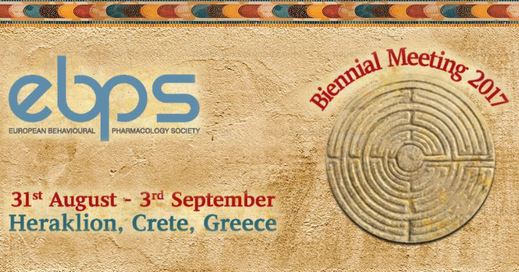Our Lab presented recent data on morphine's pharmacology
at the 2017 meeting of the European Behavioural Pharmacology Society (Heraklion, Crete, Greece)
at the 2017 meeting of the European Behavioural Pharmacology Society (Heraklion, Crete, Greece)
Abstract
Morphine is the gold-standard for the treatment of chronic or cancer pain in diverse dosing regimens. Nevertheless, morphine’s long-term use is severely limited by its biphasic side-effects on motor behavior (inhibitory or excitatory) and the manifestation of analgesic tolerance (e.g. reduced analgesic efficacy). Despite our increasing knowledge on morphine’s activity, little is known about the role of its dosing to the manifestation of biphasic motor effects and analgesic tolerance. Understanding how morphine’s dosing contributes to behaviour is crucial towards future clinical strategies for reducing morphine’s side-effects and tolerance.
In our study we administered repetitive subcutaneous morphine in rats, using two different regimen groups (Group A: 5 mg/kg/day b.i.d. for 5 days followed by 10mg/kg/day for 11 days & Group B: 10mg/kg/day b.i.d. for 10 days, followed by 20mg/kg/day for 4 days), for 14 days. Animals were observed for their motor/exploratory behaviours (distance travelled, speed, moving-time, rearing, rotation) in an open-field arena of a Multi-Conditioning System with 3D infra-red sensors, prior to and until 180mins after each injection. Antinociception was recorded using a standard tail-flick assay.
We show that animals treated with the low morphine dose developed reduced motor behaviours, which did not desensitize upon repetitive administration, even during the development of antinociceptive tolerance. However, animals treated with a higher morphine dose developed acute depressive behaviours that quickly desensitized to basal levels and progressed to an excitatory phase after 10 days upon antinociceptive tolerance. Rearing behaviour was the only observed behaviour that remained in an inhibitory state irrespective of dosing. The excitatory phase of high-dose morphine dissipated to an inhibitory phase upon introduction of a single double-size dose.
Our results suggest that morphine dosing determines the expression profile of morphine’s behavioural effects and that antinociceptive tolerance is linked to the excitatory phase of morphine’s motor effects.
Morphine is the gold-standard for the treatment of chronic or cancer pain in diverse dosing regimens. Nevertheless, morphine’s long-term use is severely limited by its biphasic side-effects on motor behavior (inhibitory or excitatory) and the manifestation of analgesic tolerance (e.g. reduced analgesic efficacy). Despite our increasing knowledge on morphine’s activity, little is known about the role of its dosing to the manifestation of biphasic motor effects and analgesic tolerance. Understanding how morphine’s dosing contributes to behaviour is crucial towards future clinical strategies for reducing morphine’s side-effects and tolerance.
In our study we administered repetitive subcutaneous morphine in rats, using two different regimen groups (Group A: 5 mg/kg/day b.i.d. for 5 days followed by 10mg/kg/day for 11 days & Group B: 10mg/kg/day b.i.d. for 10 days, followed by 20mg/kg/day for 4 days), for 14 days. Animals were observed for their motor/exploratory behaviours (distance travelled, speed, moving-time, rearing, rotation) in an open-field arena of a Multi-Conditioning System with 3D infra-red sensors, prior to and until 180mins after each injection. Antinociception was recorded using a standard tail-flick assay.
We show that animals treated with the low morphine dose developed reduced motor behaviours, which did not desensitize upon repetitive administration, even during the development of antinociceptive tolerance. However, animals treated with a higher morphine dose developed acute depressive behaviours that quickly desensitized to basal levels and progressed to an excitatory phase after 10 days upon antinociceptive tolerance. Rearing behaviour was the only observed behaviour that remained in an inhibitory state irrespective of dosing. The excitatory phase of high-dose morphine dissipated to an inhibitory phase upon introduction of a single double-size dose.
Our results suggest that morphine dosing determines the expression profile of morphine’s behavioural effects and that antinociceptive tolerance is linked to the excitatory phase of morphine’s motor effects.

